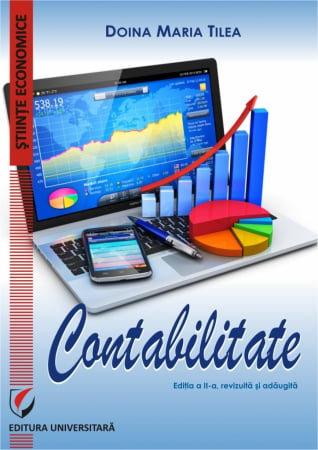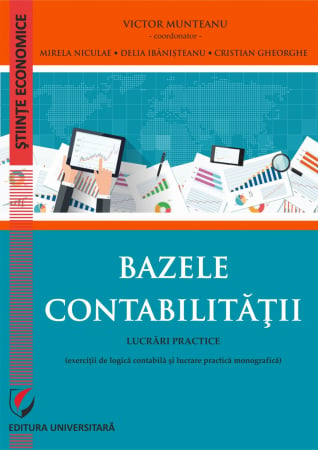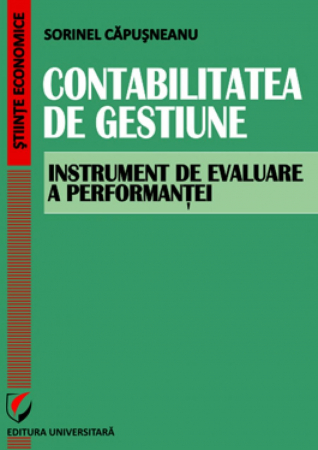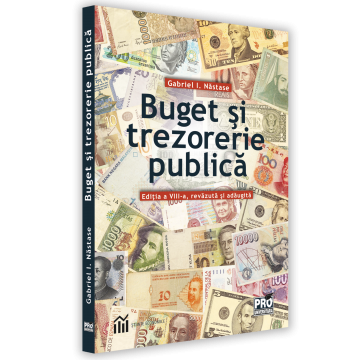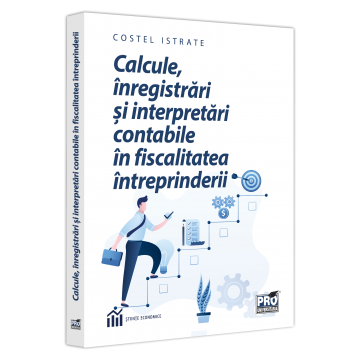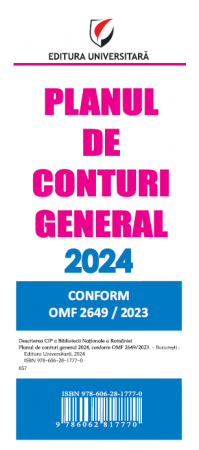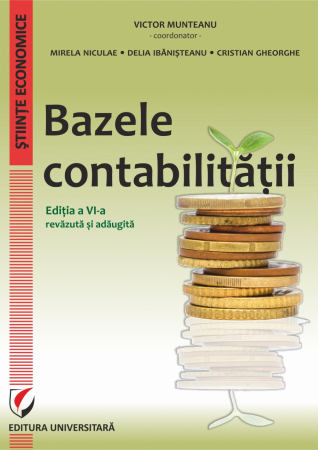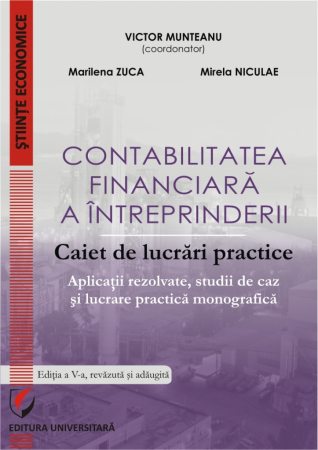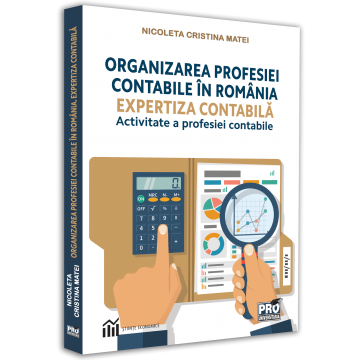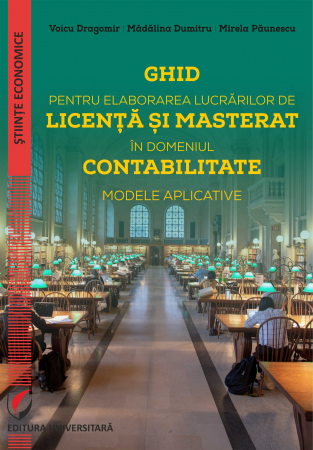6359.png) Accounting. From theory to practice. Method and modeling / The accounting cycle and the closing of the financial year, 6th edition, added and revised - Traian-Ovidiu Calota
Accounting. From theory to practice. Method and modeling / The accounting cycle and the closing of the financial year, 6th edition, added and revised - Traian-Ovidiu Calota
Publisher: Editura Universitara
Author: Traian-Ovidiu Calota
Edition: 6th
Pages: 658
Publisher year: 2024
ISBN: 978-606-28-1770-1 / 978-606-28-1769-5
DOI: 10.5682/9786062817701 / 10.5682/9786062817695
- Description
- Download (1)
- Authors
- Content
- More details
- Reviews (0)
Therefore, it can be said that, by detailing in the ways described above the issue of accounting, starting with its role and place in the organization and management of economic activities, the working method, highlighting and reporting the state of an economic entity, this new edition is constituted in - an important tool, available to all those interested in learning and specializing in this field. At the same time, the book is accessible and useful to managers at all hierarchical levels, as it provides them with the theoretical and practical basis necessary for the efficient organization and management of economic activities.
Last but not least, a series of important aspects have been inserted in the book that contribute to the highlighting of the scientific character of accounting, as well as to the creation of premises for the further improvement of accounting as an informational system and, implicitly, as a science. In this sense, the general problem of economic theories and mechanisms was addressed, but also the one related to the establishment and organization of commercial companies, the relationship within them, the relationship of accounting with taxation and management, as well as the impact of managerial decisions on the result.
Finally, we appreciate that this new edition offers the reader an overview of the major role of accounting in the initiation and development of economic-financial transactions.
***
The work "Accounting. From theory to practice. The accounting cycle and the closing of the financial exercise" aims to complete the area described in "Accounting. From theory to practice. Method and modelling" by detailing in a form accessible to beginners, but also useful to practitioners, the main aspects related to the analysis and operation of accounts, the accounting cycle, the closing of the exercise, as well as the interconnection with taxation (VAT mechanism, taxation of profit and incomes of micro-enterprises, taxation of dividends, etc.). The work ends with an accounting monograph that constitutes an important working tool at the users' fingertips for mastering specific accounting techniques.
In this volume, I continued the application of the method of systematization, algorithmization and presentation, in schematic form, of the complex issue, thus achieving not only a condensation of the content but above all the efficiency of understanding and implicitly of learning.
The presented arguments recommend this work to all those who want to study accounting in the wider context of economic preparation, but also to those who need some details necessary to deepen their knowledge and perfect their practice in the field.
An important element of originality is the interactive character of the practical applications, in the sense that the reader is invited to complete some parts of the analysis and the accounting formula with the concrete data found in the statement of the problem. Based on direct observations but also on the pertinent suggestions made by my students, the 6th edition brings important changes regarding the introduction of communication exercises, a development of theoretical and practical approaches regarding the analysis of annual financial statements, etc.
All this we hope to write the work "Accounting. From theory to practice. The accounting cycle and the closing of the financial exercise" in the overall efforts of specialists in the field, to provide users with the most effective learning and working tools.
-
Accounting. From theory to practice. Method and modeling / The accounting cycle and the closing of the financial year, 6th edition, added and revised - Traian-Ovidiu Calota
Download
FOREWORD / 10
CHAPTER 1. THE ROLE AND PLACE OF ACCOUNTING IN THE ORGANIZATION AND MANAGEMENT OF ECONOMIC ACTIVITIES / 11
1.1. General considerations / 11
1.2. Object and terminological specifications / 15
1.3. Accounting functions / 22
1.4. Accounting principles / 23
1.5. Accounting method / 29
1.6. The structure, organization and management of accounting / 34
CHAPTER 2. RECOGNITION AND REPORTING OF THE STATUS OF AN ECONOMIC ENTITY / 37
2.1. General aspects regarding the accounting regulations applicable in Romania / 38
2.2. General aspects regarding the annual financial statements of entities applying Order 1802/2014 / 41
2.2.1. What is meant by the financial exercise? / 41
2.2.2. How are reporting entities classified? / 42
2.2.3. What is the type of reporting according to the entity category? / 43
2.2.4. Who prepares and signs the annual financial statements? / 46
2.2.5. What is the deadline for preparation and submission? / 46
2.2.6. Are companies obliged to publish their financial statements? / 47
2.2.7. Who are the users of the annual financial statements? / 48
2.2.8. What is the usefulness of the accounting information from the annual financial statements from the perspective of management? / 49
2.2.9. Communication exercises / 51
2.3. Accounting balance sheet / 52
2.3.1. Definition, form and structure / 52
2.3.2. The role and structure of heritage elements / 57
2.3.2.1. Active / 57
2.3.2.2. The passive / 68
2.3.2.3. Communication exercises / 77
2.3.3. The impact of operations on the heritage / 88
2.3.3.1. Analysis of balance sheet changes through the prism of the effect of economic-financial operations on the relationship Assets = Liabilities / 88
2.3.3.2. Analysis of balance sheet changes through the prism of the effect of economic-financial operations on the relationship: A – D = C / 93
2.3.3.3. Communication exercises / 97
2.4. "Profit and loss" account (results account) / 99
2.4.1. The profit and loss account - a tool for measuring and reporting the economic entity's performance / 99
2.4.2. The structure and format of the profit and loss account / 99
2.4.2.1. Recognition of current expenses / 100
2.4.2.2. Recognition of current income / 106
2.4.2.3. Current expenses and income versus expenses and income recorded in advance / 13
2.4.2.4. Structuring current expenses / 115
2.4.2.5. Structuring current income / 117
2.4.2.6. The format of the results account / 118
2.4.2.7. Communication exercises / 121
2.5. The situation of changes in equity / 124
2.6. Cash flow situation / 126
2.6.1. Generalities / 126
2.6.2. Classifications of accounting regulations / 126
2.6.3. Direct method case study / 134
2.6.4. The model of the cash flow situation by the direct method / 136
2.6.5. Communication exercises / 140
2.7. Explanatory notes to the annual financial statements / 143
CHAPTER 3. ACCOUNTS SYSTEM / 145
3.1. Accounting account / 145
3.1.1. Account definition and configuration / 145
3.1.2. Account operation rules / 151
3.1.3. Single and double registration / 152
3.1.3.1. Simple registration / 152
3.1.3.2. Double registration / 153
3.2. Accounting analysis of economic-financial operations. Accounting formula. Accounting article / 154
3.2.1. Accounting analysis and configuration of the accounting formula / 154
3.2.2. Classification of the accounting formula / 156
3.2.2.1 Simple accounting formula / 156
3.2.2.2. Compound accounting formula / 156
3.2.2.3. Current accounting formula / 158
3.2.2.4. Cancellation accounting formula / 158
3.2.2.5. Case study / 160
3.3. Classification of accounts / 164
3.4. Communication exercises / 165
3.5. The general chart of accounts / 170
3.5.1. Treasury accounts / 172
3.5.2. Inventory accounts / 173
3.5.3. Fixed assets accounts / 176
3.5.4. Accounts receivable / 182
3.5.5. Debt accounts / 183
3.5.6. Expense accounts / 187
3.5.7. Income accounts / 187
3.5.8. Capital accounts / 188
3.5.9. Test the grid / 191
3.5.10. Communication exercises / 195
3.6. Verification balance / 212
3.6.1. Definition and functions / 212
3.6.2. Classification / 213
3.6.3. Preparation methodology / 214
3.6.4. Exemplification of the preparation method / 215
3.6.5. Case study / 221
3.6.6. Communication exercises / 243
3.6.7. Proposed exercises for solving / 247
CHAPTER 4. FINANCIAL-ACCOUNTING DOCUMENTS / 249
4.1. Defining. Functions and classification / 249
4.2. Supporting documents / 250
4.3. Accounting registers / 252
4.4. Case studies / 256
4.5. Communication exercises / 277
CHAPTER 5. EVALUATION IN ACCOUNTING / 281
5.1. Principles of evaluation / 281
5.2. Elements of the evaluation technique in accounting / 282
5.2.1. Entrance assessment / 283
5.2.2. Evaluation at the exit / 286
5.2.3. Cost estimation techniques / 297
5.3. Proposed exercises to solve / 300
BIBLIOGRAPHY / 303
LIST OF FIGURES / 305
Annex 1 GENERAL CHART OF ACCOUNTS / 306
***
INTRODUCTION / 9
THANKS / 10
CHAPTER 1. ANALYSIS AND OPERATION OF ACCOUNTS / 11
1.1. Capital accounts / 11
1.1.1. Analysis and operation scheme / 12
1.1.2. Exemplification / 13
1.1.3. Communication exercises / 19
1.2. Fixed assets accounts / 23
1.2.1. Analysis and operation scheme / 23
1.2.2. Exemplification / 25
1.2.3. Communication exercises / 35
1.3. Inventory accounts, debts and trade receivables / 40
1.3.1. Analysis of VAT accounts, debts and trade receivables / 41
1.3.2. Case study for VAT defaulters / 43
1.3.3. The VAT mechanism in the classic system / 51
1.3.4. VAT accounting / 56
1.3.5. Case study for classic VAT payers (on invoicing) / 59
1.3.6. Case study for VAT payers on collection / 65
1.3.7. Complex case study / 73
1.3.7.1. Variant 1: VAT under normal regime (VAT on invoicing) / 74
1.3.7.2. Option 2: The company is a VAT payer upon receipt / 76
1.3.7.3. Option 3: The company applies VAT on invoicing and the partners apply VAT on collection / 79
1.3.8. Communication exercises / 81
1.4. Other third party accounts and debts / 88
1.4.1. Salary and social debt accounts / 88
1.4.1.1. Analysis and operation scheme / 89
1.4.1.2. Exemplification / 92
1.4.1.3. Communication exercises / 98
1.4.2. Accounts of various debtors and creditors / 101
1.4.2.1. Analysis and operation scheme / 101
1.4.2.2. Exemplification / 102
1.5. Treasury accounts / 104
1.5.1. Analysis and operation scheme / 105
1.5.2. Exemplification / 106
1.5.3. Complex case study / 110
1.5.4. Communication exercises / 119
1.6. Expense accounts / 124
1.7. Income accounts / 124
1.7.1. Profit tax payer case study / 126
1.7.1.1. Calculation of profit tax / 126
1.7.1.2. Operations related to the distribution of profit / 138
1.7.2. Case study microenterprise income tax / 140
1.7.2.1. Tax determination methodology / 140
1.7.2.2. Case study / 145
1.7.3. Proposed exercises for solving / 163
1.8. Special accounts / 167
1.9. Management accounts / 167
CHAPTER 2. THE ACCOUNTING CYCLE / 168
2.1. Legal specifications regarding the organization of accounting / 168
2.2. Operating cycle / 169
2.3. Financial-accounting documents / 171
2.4. Registration forms for taxpayers who conduct double-entry accounting / 172
CHAPTER 3. CLOSING OF THE FINANCIAL YEAR / 178
3.1. Asset inventory / 180
3.1.1. General considerations / 180
3.1.2. Pre- and post-inventory activities / 181
3.1.3. Succession of inventory activities / 181
3.1.4. Inventory methodology / 182
3.1.5. Evaluation of inventoried assets and liabilities / 186
3.1.6. Case study regarding the updating of receivables, debts and availabilities in foreign currency / 188
3.1.7. Case study regarding the establishment and resumption of adjustments for the depreciation of receivables / 193
3.1.8. Case study regarding the establishment and resumption of provisions for future risks / 196
3.2. Preparation and presentation of the accounting balance sheet / 198
3.3. Preparation and presentation of the results account / 210
3.4. Highlights regarding the analysis of annual financial statements / 220
3.4.1. Elements of financial position analysis / 221
3.4.2. Elements regarding the analysis of financial performance and the analysis of profitability rates / 225
3.4.3. Case study / 227
CHAPTER 4. ACCOUNTING MONOGRAPH / 237
4.1. Presentation of transactions and events from the year of establishment / 237
4.2. Presentation and registration of accounting documents / 241
4.3. Presentation of the journal register / 271
4.4. Presentation for completion of the account sheet / 274
4.5. Preparation of the trial balance / 279
4.6. Monograph appendices / 281
4.6.1. Sales and purchase journals / 281
4.6.2. Tax declarations / 282
4.6.2.1. Declaration 100 / 282
4.6.2.2. Declaration 112 / 284
4.6.2.3. Invoice 300 VAT / 294
4.7. Inventory / 299
4.7.1. Inventory decision / 299
4.7.2. Management statements / 300
4.7.3. Tangible assets inventory list / 302
4.7.4. Account statement / 302
4.7.5. Inventory report / 303
4.8. Annual financial statements / 308
4.8.1. The abridged balance sheet / 308
4.8.2. Abridged profit and loss account / 311
4.9. Presentation of transactions and events from the first month of the following year / 312
BIBLIOGRAPHY / 317
LIST OF FIGURES / 320
LISTS OF INTEREST / 321
Appendix 1. GENERAL CHART OF ACCOUNTS ACCORDING TO OMFP 1802/2014/328
Such a search takes place between normative and positive, constructive and specific good practices, between pecuniary and social.
Discussed through the prism of the above approach, the specialized book entitled "Accounting. From theory to practice. "Method and modeling" acquires a special meaning and usefulness for all those who want to learn the principles, concepts, rules, conventions, professional reasoning and practices specific to the field of accounting. For all "producers" and users of economic and financial information, they find in the present work a theoretically grounded answer to accounting mechanisms.
Related to the need of the university specializing in economics, this specialized book offers the theoretical and methodological foundations of accounting as a scientific educational discipline. It discusses questions, ideas, concepts, theses and solutions regarding the organization and operation of accounting. And to be adequate, the book is generous with everything that is paradigm, theory and method in the science of accounting, it has the essence, relevance and application in the field of accounting treatments oriented towards the collection, processing and presentation of information in financial statements.
Also, the work provides information equally for all users of accounting information, be they capital investors, lenders, creditors, public institutions, informational institutions, but also enterprise and business managers. From the sphere of interest in the basics of accounting, you should not forget accounting experts and certified accountants. In this sense, the work can be considered as theoretical and practical support that invites improvement and development.
The content and reasoning forms of the book benefit from the accumulation of specialized literature and the provisions of accounting standards and regulations. The positive, the normative and the constructive can be found in the content of this accounting book.
In the end, the work gives me the opportunity to tell you to accept it as a theory and method regarding the model and modeling in an accounting that is in a state of searching and finding.
UNIVERSITY PROFESSOR, DOCTOR
Mihai RISTEA
Customer Support Monday - Friday, between 8.00 - 16.00
0745 200 718 0745 200 357 comenzi@editurauniversitara.ro
![Accounting. From theory to practice. Method and modeling / The accounting cycle and the closing of the financial year, 6th edition, added and revised - Traian-Ovidiu Calota [1] Accounting. From theory to practice. Method and modeling / The accounting cycle and the closing of the financial year, 6th edition, added and revised - Traian-Ovidiu Calota [1]](https://gomagcdn.ro/domains/editurauniversitara.ro/files/product/large/contabilitate-de-la-teorie-la-practica-metoda-si-modelare-ciclul-contabil-si-inchiderea-exercitiului-financiar-editia-a-vi-a-adaugita-si-revizuita-tra-128638.jpg)
